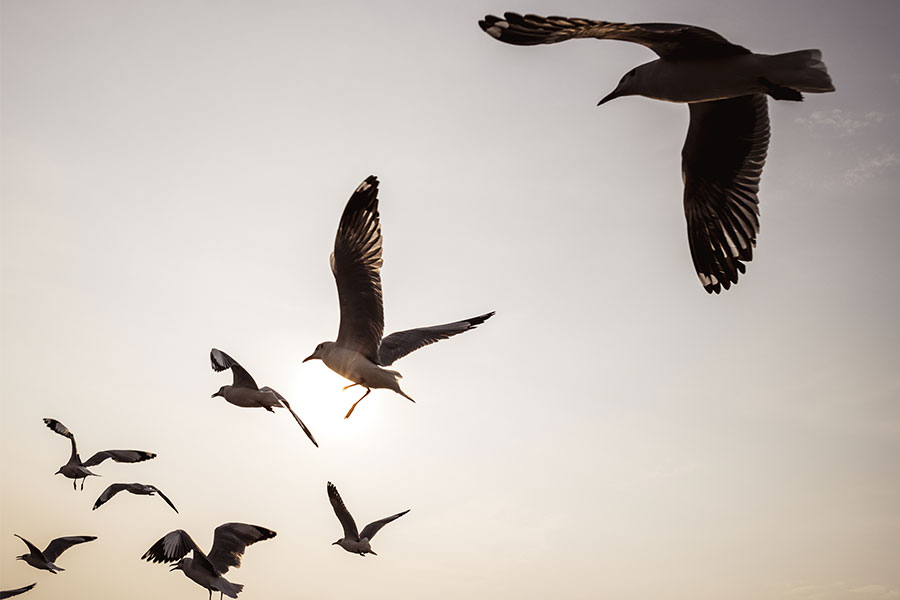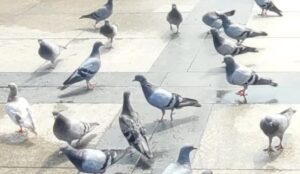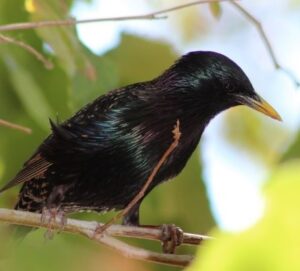Legal Considerations
With very few exceptions, all birds are protected by laws and regulations.
Habitat Modification
Habitat modification for birds means limiting a bird’s food, water, or shelter. Attempting to limit the food or water of pigeons, starlings, and house sparrows limiting is not practical. These birds will have a number of feeding and watering sites — often far from roosting and loafing sites. Where people are feeding birds in parks or lunch areas, education can help reduce this source of food; and in most cases, people will pay little attention to requests to stop.
The most successful kind of habitat modification is to exclude the birds from their roosting and loafing sites (addressed in the section on exclusion). Pigeons may be induced to move from an infested site by the persistent destruction of nests and eggs.
Exclusion
Attempts should be made to exclude birds from buildings. Some building designs and conditions lend themselves to bird infestation. Flat ledges, openings in water towers and vents, unscreened windows, and other attributes make a building an attractive location for roosting, nesting, and loafing. Modification or repair can exclude birds.
Typical solutions include replacing broken windows and screens, eliminating large crevices, blocking openings into vents, cooling towers, and roof-top equipment with hardware cloth. Exclusion methods also includes the use of netting, custom-designed sheet-metal or plastic
covers, porcupine wire (Nixalite, for example), electrified wires, and sticky repellents to keep birds from roosting on ledges, roof edges, window sills, building signs, and other surfaces favoured by pest birds. Two advantages are that the birds are not killed and the control is comparatively long-lasting.
1 Netting.
Netting is used to block access of birds to large roosting areas in structures. Netting is especially useful in warehouses and around mechanical equipment areas where aesthetics are of minor consideration. It has been used successfully on cooling towers. Plastic nets have replaced metal and fiber nets in bird control. Plastic nets are normally extruded black polypropylene and are made with an ultraviolet inhibitor to reduce UV degradation. Knotted nets are also available. Nets will last from 2-5 years depending on exposure to sunlight.
2 Covers or Ramps.
Custom-designed covers for ledges, window air conditioning units, and roof edges are the best technical solution to keep birds from infesting these sites. The high cost of this method usually eliminates this option on large buildings that have extensive roosting sites. But covers are valid options where limited applications will keep birds off selected sites, and where aesthetics are an important consideration. The covers usually consist of sheet metal installed at a 45 degree angle to prevent the birds from landing. Sometimes plastic inserts are custom-fit into the indentations in order to block off ledges.
3 Spikes.
Porcupine wire, sharp metal spikes, or any similar “bed of nails” can stop birds from roosting on ledges. Where they can be used, they usually work fairly well. If aesthetics are important, these devices are usually limited to areas where they cannot be easily seen.
If pigeons are likely to drop nest material and other debris on top of the newly installed spikes in an attempt to create a new roosting surface, install metal spikes on potential landing sites above the installation. Check metal spikes every six months for accumulated debris or nest material.
Advise clients to regularly remove falling autumn leaves and other matter that can cover the spikes and reduce their effectiveness. Ensure that no tree branches hang over protected ledges.
4 Sticky Repellents.
Sticky repellents are tacky gels or liquids. The products are designed to be sticky enough to make a bird uncomfortable, but not so sticky that the birds are trapped. After a few attempts, the birds stop trying to land on treated surfaces. The active ingredient is polybutene or isopolybutene (the same substances used in some adhesive bandages) or petroleum naphthenic oils. Before applying sticky repellents, clean ledges that are covered by bird droppings, feathers, and nest material with a wire brush, paint scraper, high pressure hoses, or by steam cleaning.
Ensure that surfaces are clean and dry.
Seal concrete, unpainted wood, or brownstone with silicone or other sealant, paint, or shellac before applying repellent. [Sticky repellents will be absorbed into porous materials.]
Use a caulking gun to apply repellent. The depth of the bead necessary to repel different species of pest birds is roughly as follows: crows and sea gulls 3/8 inch; pigeons 1/4 inch; starlings 1/8 inch; sparrows 1/16 inch. The pattern of application will depend on the site and personal preference. The caulking gun should be held at angle of 30-45 degrees.
Apply a straight bead on ledges and roof edges, 1/2 inch from the outer edge, with another bead three inches in from the first, or they can be applied in a zig zag or “s” curve.
For another option combine a straight line 1/2 inch from the outer edge and an “s” curve three to five inches back.
Place breaks in the bead every few feet to avoid trapping rainwater against the building.
For easy removal and replacement, apply waterproof sticky repellent tape on ledge and roof edges.
Apply bulk gels with a paint roller, putty knife, or bulk caulking gun.
Apply liquids with a roller, brush, or compressed-air sprayer to girders, rods, sign supports, and rooftops. They can also be used to treat the upper surface of branches in trees and bushes. The repellent should be 1/16 to 1/8 inch thick. Liquid application is not recommended for sites where the appearance of the sticky repellent would be undesirable.
Environmental conditions, particularly dust, make a big difference in the effective life of sticky repellents. In an area with no dust, applications should be expected to remain effective for a year or more. Some sticky repellents come with a liquid coating that is sprayed onto the repellent immediately after application. The liquid dries to a brittle film that protects the material from dust and may allow it to remain effective for as long as two to five years.
Certain precautions should be followed when sticky repellents are used.
Remove nests. Check provincial and municipal regulations which may prohibit destroying or disturbing nests containing eggs or young.
Under some conditions, sticky repellents stain the surfaces to which they are applied. Some products melt and run when exposed to direct sun and high temperatures.
Review labels and the manufacturers’ technical information on the effective temperature ranges of different products.
Compare the stability of different products by running a test on a sunny roof or window ledge.
Birds occasionally get stuck in sticky repellents. When this happens, their feathers will Get gummed up, and they’ll be unable to fly. If a bird becomes gummed up with repellent, it can sometimes be rescued by cleaning the flight feathers with a small amount of mineral spirits followed by mineral oil. In most cases, cartridge applications (as described earlier) will repel the birds with little risk of entanglement.
5 Trapping
In many instances, trapping can be an effective supplemental control measure. Trapping is especially effective against pigeons. Where a group of birds are roosting or feeding in a confined and isolated area, trapping should be considered the primary control tactic.
The best time to trap pigeons is in the winter when their food is at a minimum. There are many pigeon traps to choose from; which type and size is best is debatable. Most pigeon trapping programs use large walk-in traps. These can be four to six feet high and designed to be disassembled and moved. Another common type is a low-profile bob-trap that is about eight inches to two feet high. The door or entrance through which pigeons are lured is the principle feature of a trap.
Set traps in inconspicuous places where pigeons commonly roost or feed and where traps are not likely to be vandalized (a major risk in trapping programs). Trap placement is important, and moving an inactive trap just 10-15 feet may significantly improve catches.
Feeding areas are the best trap sites, but are rarely on the same property as the roosting sites.
Roof tops that have water from cooling towers or air conditioning units are often good trapping sites in summer. The most difficult part of trapping is motivating birds to feed in a nonfeeding area so that they will follow the bait into the trap. Whole corn or sorghum are generally the best baits but wheat, milo, oat groats, millet, popcorn, sunflower seeds, peas, greens, bread, or peanuts can be very effective if the birds are feeding on similar food. Once a few birds have been trapped, putting different foods in with the birds can show which bait they prefer.
In the first few weeks of a program, scatter small quantities of bait throughout the area to start the birds feeding and determine the best trap sites. Some specialists leave traps propped open for the first few days to allow the birds to get used to them. When the birds are calmly entering the trap, set it. Put bait and water (a “chick font” is ideal) inside the trap and just a handful or so outside the trap.
Leave one or two “decoy” birds in the trap to draw in other birds. Remove trapped birds regularly (except for decoys), otherwise other pigeons will be frightened by fluttering trapped pigeons in the trap. Since pigeons can fly great distances and find their way home, trap and release is not normally effective. In most cases, trapped birds should be humanely destroyed. Some experts recommend gassing with calcium cyanide but many feel it is simpler and more humane to kill the bird by breaking its neck.
Sometimes indoor roosting sites can be used as a giant trap. Pigeons often use attics, rooftop elevator houses, or empty floors of poorly maintained structures as nest and roost sites. By screening all but one or two entrances these areas can be made into a giant trap. Late in the evening (after about a two-week acclimation period) these last entrances can be closed down after the pigeons have settled down for the night. The trapped birds can then be captured by hand or with “butterfly” nets.
Sparrow traps come in various sizes and shapes.The sparrow funnel trap is a double funnel that prevent sparrows from escaping after they have travelled through two funnels going for a food bait. Fine cracked corn, millet, wheat, or bread crumbs make good bait. Trap sites should be baited for a few days before you actually begin trapping. Sparrow traps are usually more effective when placed on the ground. Nest box traps attract a sparrow with a potential nest site.
Once inside, the bird trips the mechanism, dumping the bird into a collecting bag. This trap also works against starlings, as does the center drop trap. The birds, attracted by food, drop through an opening and cannot escape. However, starlings are not usually good candidates for trapping programs.
Bird Droppings Removal and Clean-up Workers removing large quantities of bird droppings should follow these precautions to minimize risk from disease organisms in the droppings:
- Wear a respirator that can filter particles down to 0.3 microns.
- Wear disposable protective gloves, hat, coveralls, and boots.
- Wet down the droppings to keep spores from becoming airborne, and keep wet.
- Put droppings into sealed plastic garbage bags and wet down the outside of the bags.
- When finished, and while still wearing the respirator, remove the protective clothing and place them in a plastic bag.
- Dispose of trash bags. (Disposal should be permissible through standard trash pick-up.)
- Wash up or shower.




